Assistance And Access Act 2018
VerifiedAdded on 2022/07/29
|8
|2511
|24
AI Summary
Contribute Materials
Your contribution can guide someone’s learning journey. Share your
documents today.
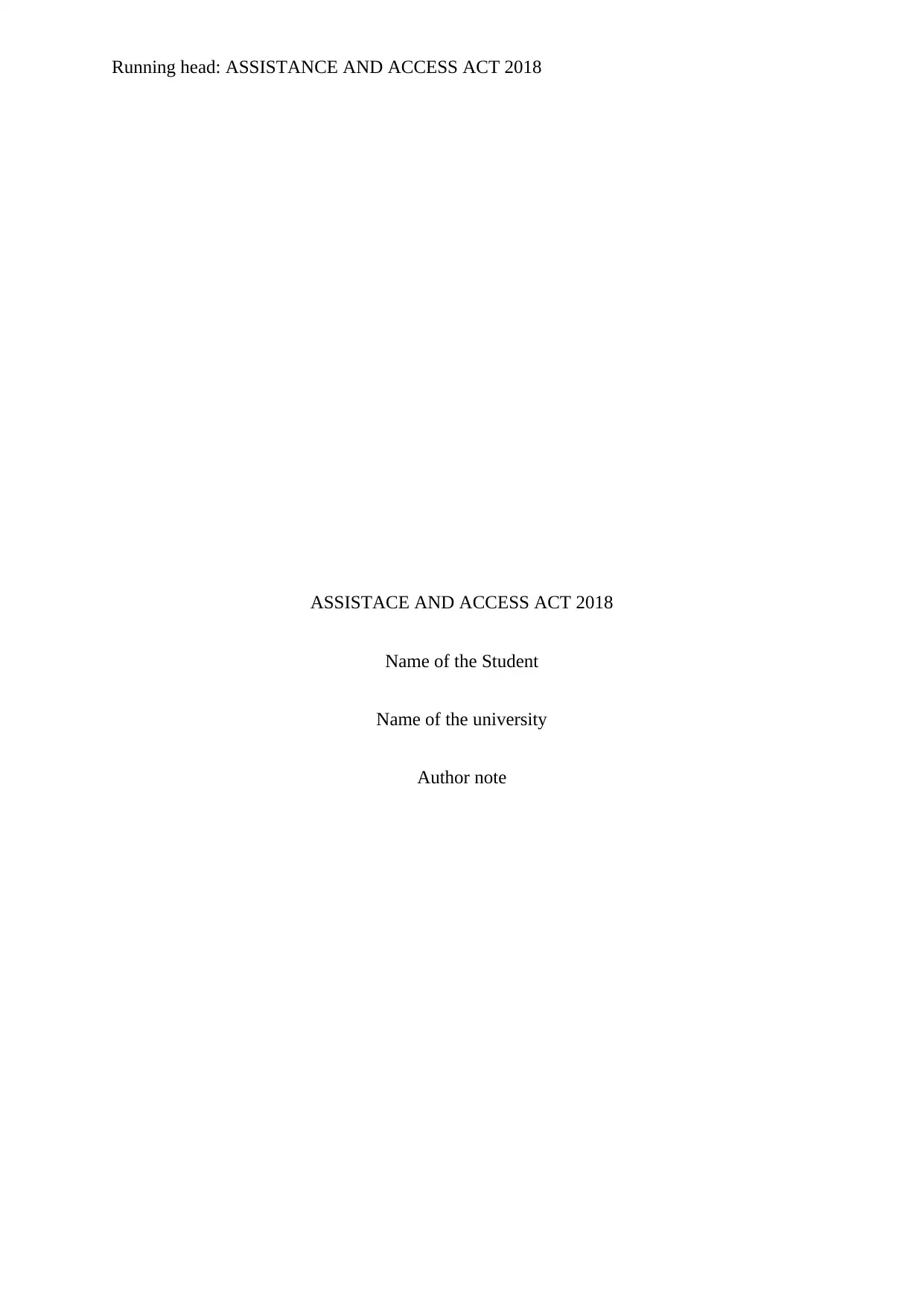
Running head: ASSISTANCE AND ACCESS ACT 2018
ASSISTACE AND ACCESS ACT 2018
Name of the Student
Name of the university
Author note
ASSISTACE AND ACCESS ACT 2018
Name of the Student
Name of the university
Author note
Secure Best Marks with AI Grader
Need help grading? Try our AI Grader for instant feedback on your assignments.

1ASSISTANCE AND ACCESS ACT 2018
Introduction and Context
The Telecommunication and Other Legislation Amendment Bill which is also termed
as the Assistance and Access Bill was passed in the year 2018. In this era where the entire
system of data is stored in the form of electronic data by the means of digitization this act was
enforced for cyber security tools and techniques which would help in creating an
environment for safe online activities in Australia (Kopsias, 2019). One of the most common
aspect used as per this act are the tools for the encryption of the data. Data encryption ensures
security of digital transactions like, shopping or banking online and also helps in securing the
data files and others present in the computer memory, hard disk or cloud. With the help of
several algorithms and technologies along with internet, encryption of the data has been much
easier (Adams, 2016). However, this acts has a dark side as well, allowing the drug
smugglers, human traffickers and even terrorists to hide valuable information and cover their
elicit activities which helps a lot in their crimes. With criminal organizations getting
increasingly digitally sophisticated the use of internet technology and cyber laws and acts like
these for their own benefits grows easier for them. In recent times due to the vast changes in
the technology valuable data, forensic evidence and intelligence report have slowly gone
useless or have been destroyed by criminal master minds.
The Going Dark Debate of the United States is based on this act as well. According to the
debate, the US government decides upon usage of the weak encryption of the data
applications, which would make it easier for the intelligence bureau to track the illegal
activities that go on with the help of the internet (Gasser et al., 2016). The crimes like the
trafficking, drug dealing and the others make good usage of the encryption mechanism to
protect the “darkest” of the secrets. Eavesdropping for the government agencies becomes
extremely difficult. The act which was meant for the protection of the privacy of the
Introduction and Context
The Telecommunication and Other Legislation Amendment Bill which is also termed
as the Assistance and Access Bill was passed in the year 2018. In this era where the entire
system of data is stored in the form of electronic data by the means of digitization this act was
enforced for cyber security tools and techniques which would help in creating an
environment for safe online activities in Australia (Kopsias, 2019). One of the most common
aspect used as per this act are the tools for the encryption of the data. Data encryption ensures
security of digital transactions like, shopping or banking online and also helps in securing the
data files and others present in the computer memory, hard disk or cloud. With the help of
several algorithms and technologies along with internet, encryption of the data has been much
easier (Adams, 2016). However, this acts has a dark side as well, allowing the drug
smugglers, human traffickers and even terrorists to hide valuable information and cover their
elicit activities which helps a lot in their crimes. With criminal organizations getting
increasingly digitally sophisticated the use of internet technology and cyber laws and acts like
these for their own benefits grows easier for them. In recent times due to the vast changes in
the technology valuable data, forensic evidence and intelligence report have slowly gone
useless or have been destroyed by criminal master minds.
The Going Dark Debate of the United States is based on this act as well. According to the
debate, the US government decides upon usage of the weak encryption of the data
applications, which would make it easier for the intelligence bureau to track the illegal
activities that go on with the help of the internet (Gasser et al., 2016). The crimes like the
trafficking, drug dealing and the others make good usage of the encryption mechanism to
protect the “darkest” of the secrets. Eavesdropping for the government agencies becomes
extremely difficult. The act which was meant for the protection of the privacy of the
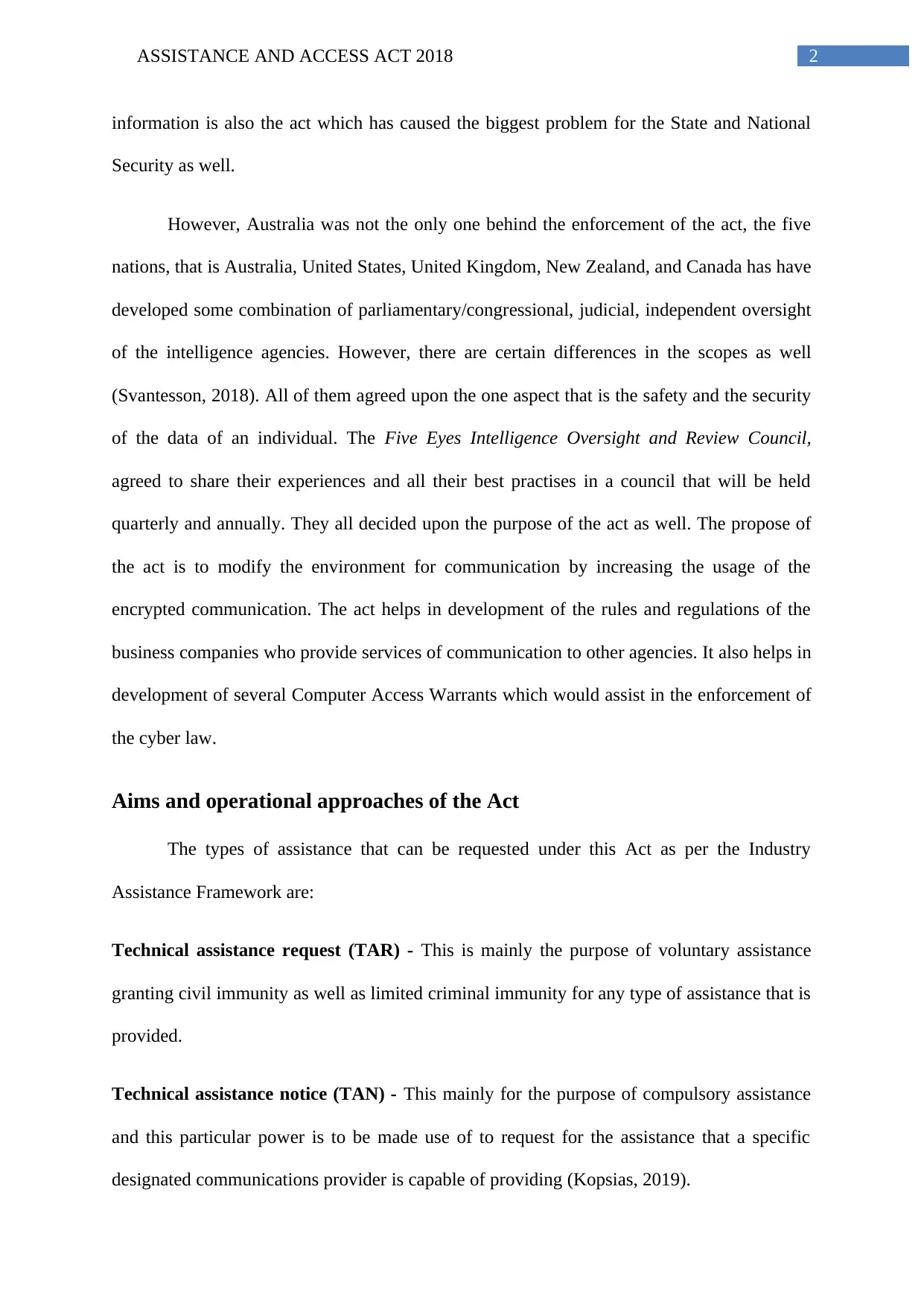
2ASSISTANCE AND ACCESS ACT 2018
information is also the act which has caused the biggest problem for the State and National
Security as well.
However, Australia was not the only one behind the enforcement of the act, the five
nations, that is Australia, United States, United Kingdom, New Zealand, and Canada has have
developed some combination of parliamentary/congressional, judicial, independent oversight
of the intelligence agencies. However, there are certain differences in the scopes as well
(Svantesson, 2018). All of them agreed upon the one aspect that is the safety and the security
of the data of an individual. The Five Eyes Intelligence Oversight and Review Council,
agreed to share their experiences and all their best practises in a council that will be held
quarterly and annually. They all decided upon the purpose of the act as well. The propose of
the act is to modify the environment for communication by increasing the usage of the
encrypted communication. The act helps in development of the rules and regulations of the
business companies who provide services of communication to other agencies. It also helps in
development of several Computer Access Warrants which would assist in the enforcement of
the cyber law.
Aims and operational approaches of the Act
The types of assistance that can be requested under this Act as per the Industry
Assistance Framework are:
Technical assistance request (TAR) - This is mainly the purpose of voluntary assistance
granting civil immunity as well as limited criminal immunity for any type of assistance that is
provided.
Technical assistance notice (TAN) - This mainly for the purpose of compulsory assistance
and this particular power is to be made use of to request for the assistance that a specific
designated communications provider is capable of providing (Kopsias, 2019).
information is also the act which has caused the biggest problem for the State and National
Security as well.
However, Australia was not the only one behind the enforcement of the act, the five
nations, that is Australia, United States, United Kingdom, New Zealand, and Canada has have
developed some combination of parliamentary/congressional, judicial, independent oversight
of the intelligence agencies. However, there are certain differences in the scopes as well
(Svantesson, 2018). All of them agreed upon the one aspect that is the safety and the security
of the data of an individual. The Five Eyes Intelligence Oversight and Review Council,
agreed to share their experiences and all their best practises in a council that will be held
quarterly and annually. They all decided upon the purpose of the act as well. The propose of
the act is to modify the environment for communication by increasing the usage of the
encrypted communication. The act helps in development of the rules and regulations of the
business companies who provide services of communication to other agencies. It also helps in
development of several Computer Access Warrants which would assist in the enforcement of
the cyber law.
Aims and operational approaches of the Act
The types of assistance that can be requested under this Act as per the Industry
Assistance Framework are:
Technical assistance request (TAR) - This is mainly the purpose of voluntary assistance
granting civil immunity as well as limited criminal immunity for any type of assistance that is
provided.
Technical assistance notice (TAN) - This mainly for the purpose of compulsory assistance
and this particular power is to be made use of to request for the assistance that a specific
designated communications provider is capable of providing (Kopsias, 2019).
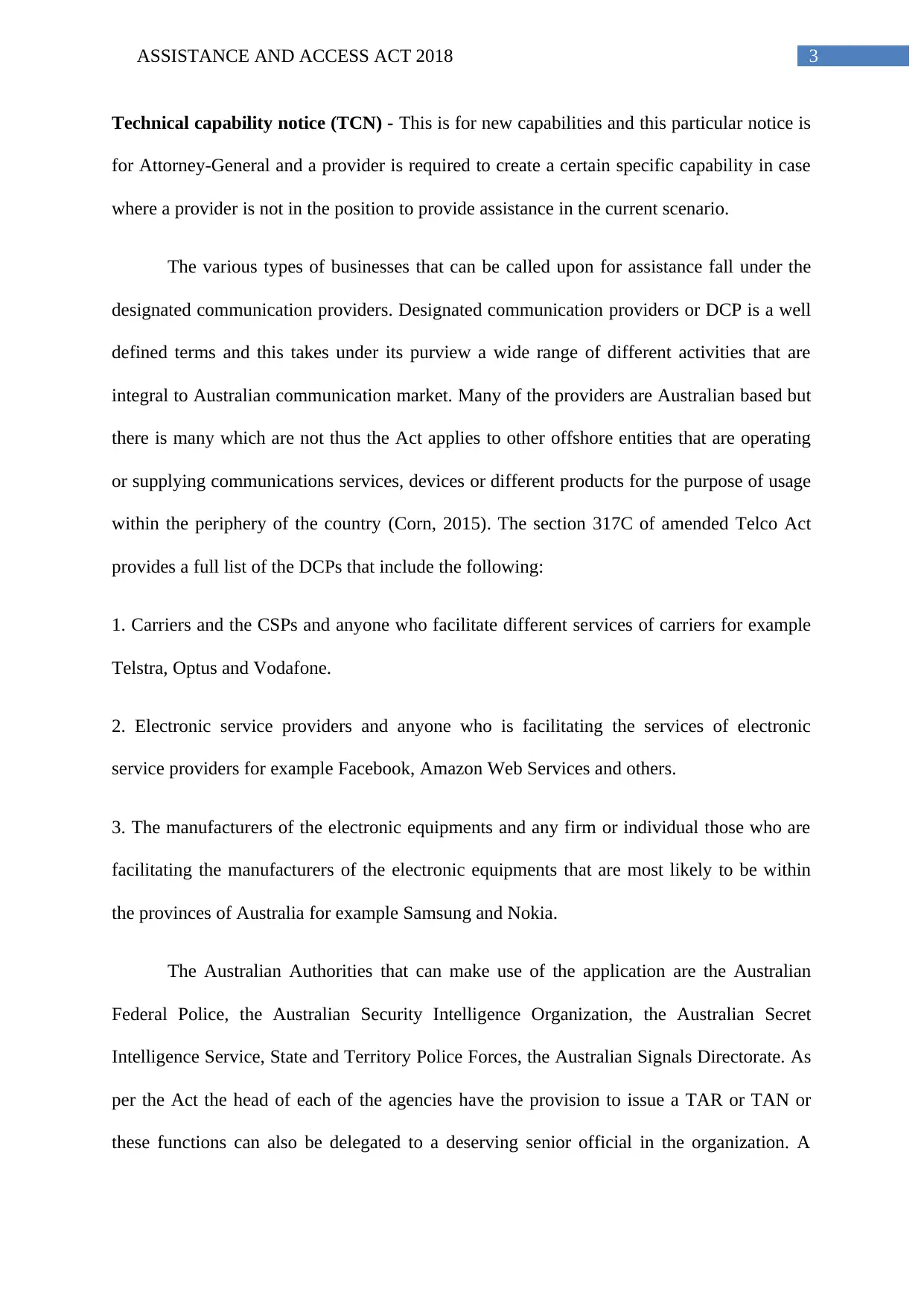
3ASSISTANCE AND ACCESS ACT 2018
Technical capability notice (TCN) - This is for new capabilities and this particular notice is
for Attorney-General and a provider is required to create a certain specific capability in case
where a provider is not in the position to provide assistance in the current scenario.
The various types of businesses that can be called upon for assistance fall under the
designated communication providers. Designated communication providers or DCP is a well
defined terms and this takes under its purview a wide range of different activities that are
integral to Australian communication market. Many of the providers are Australian based but
there is many which are not thus the Act applies to other offshore entities that are operating
or supplying communications services, devices or different products for the purpose of usage
within the periphery of the country (Corn, 2015). The section 317C of amended Telco Act
provides a full list of the DCPs that include the following:
1. Carriers and the CSPs and anyone who facilitate different services of carriers for example
Telstra, Optus and Vodafone.
2. Electronic service providers and anyone who is facilitating the services of electronic
service providers for example Facebook, Amazon Web Services and others.
3. The manufacturers of the electronic equipments and any firm or individual those who are
facilitating the manufacturers of the electronic equipments that are most likely to be within
the provinces of Australia for example Samsung and Nokia.
The Australian Authorities that can make use of the application are the Australian
Federal Police, the Australian Security Intelligence Organization, the Australian Secret
Intelligence Service, State and Territory Police Forces, the Australian Signals Directorate. As
per the Act the head of each of the agencies have the provision to issue a TAR or TAN or
these functions can also be delegated to a deserving senior official in the organization. A
Technical capability notice (TCN) - This is for new capabilities and this particular notice is
for Attorney-General and a provider is required to create a certain specific capability in case
where a provider is not in the position to provide assistance in the current scenario.
The various types of businesses that can be called upon for assistance fall under the
designated communication providers. Designated communication providers or DCP is a well
defined terms and this takes under its purview a wide range of different activities that are
integral to Australian communication market. Many of the providers are Australian based but
there is many which are not thus the Act applies to other offshore entities that are operating
or supplying communications services, devices or different products for the purpose of usage
within the periphery of the country (Corn, 2015). The section 317C of amended Telco Act
provides a full list of the DCPs that include the following:
1. Carriers and the CSPs and anyone who facilitate different services of carriers for example
Telstra, Optus and Vodafone.
2. Electronic service providers and anyone who is facilitating the services of electronic
service providers for example Facebook, Amazon Web Services and others.
3. The manufacturers of the electronic equipments and any firm or individual those who are
facilitating the manufacturers of the electronic equipments that are most likely to be within
the provinces of Australia for example Samsung and Nokia.
The Australian Authorities that can make use of the application are the Australian
Federal Police, the Australian Security Intelligence Organization, the Australian Secret
Intelligence Service, State and Territory Police Forces, the Australian Signals Directorate. As
per the Act the head of each of the agencies have the provision to issue a TAR or TAN or
these functions can also be delegated to a deserving senior official in the organization. A
Secure Best Marks with AI Grader
Need help grading? Try our AI Grader for instant feedback on your assignments.
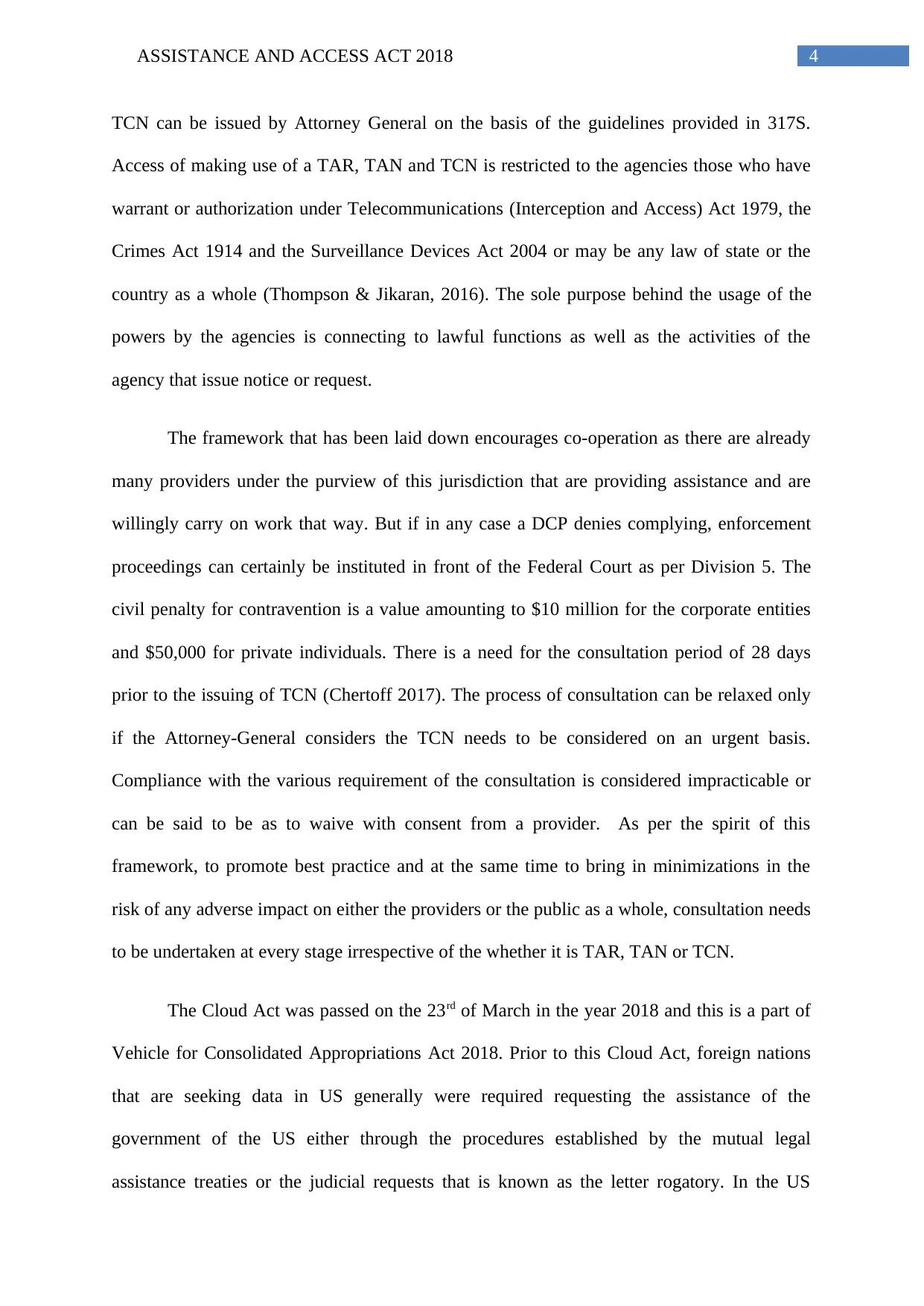
4ASSISTANCE AND ACCESS ACT 2018
TCN can be issued by Attorney General on the basis of the guidelines provided in 317S.
Access of making use of a TAR, TAN and TCN is restricted to the agencies those who have
warrant or authorization under Telecommunications (Interception and Access) Act 1979, the
Crimes Act 1914 and the Surveillance Devices Act 2004 or may be any law of state or the
country as a whole (Thompson & Jikaran, 2016). The sole purpose behind the usage of the
powers by the agencies is connecting to lawful functions as well as the activities of the
agency that issue notice or request.
The framework that has been laid down encourages co-operation as there are already
many providers under the purview of this jurisdiction that are providing assistance and are
willingly carry on work that way. But if in any case a DCP denies complying, enforcement
proceedings can certainly be instituted in front of the Federal Court as per Division 5. The
civil penalty for contravention is a value amounting to $10 million for the corporate entities
and $50,000 for private individuals. There is a need for the consultation period of 28 days
prior to the issuing of TCN (Chertoff 2017). The process of consultation can be relaxed only
if the Attorney-General considers the TCN needs to be considered on an urgent basis.
Compliance with the various requirement of the consultation is considered impracticable or
can be said to be as to waive with consent from a provider. As per the spirit of this
framework, to promote best practice and at the same time to bring in minimizations in the
risk of any adverse impact on either the providers or the public as a whole, consultation needs
to be undertaken at every stage irrespective of the whether it is TAR, TAN or TCN.
The Cloud Act was passed on the 23rd of March in the year 2018 and this is a part of
Vehicle for Consolidated Appropriations Act 2018. Prior to this Cloud Act, foreign nations
that are seeking data in US generally were required requesting the assistance of the
government of the US either through the procedures established by the mutual legal
assistance treaties or the judicial requests that is known as the letter rogatory. In the US
TCN can be issued by Attorney General on the basis of the guidelines provided in 317S.
Access of making use of a TAR, TAN and TCN is restricted to the agencies those who have
warrant or authorization under Telecommunications (Interception and Access) Act 1979, the
Crimes Act 1914 and the Surveillance Devices Act 2004 or may be any law of state or the
country as a whole (Thompson & Jikaran, 2016). The sole purpose behind the usage of the
powers by the agencies is connecting to lawful functions as well as the activities of the
agency that issue notice or request.
The framework that has been laid down encourages co-operation as there are already
many providers under the purview of this jurisdiction that are providing assistance and are
willingly carry on work that way. But if in any case a DCP denies complying, enforcement
proceedings can certainly be instituted in front of the Federal Court as per Division 5. The
civil penalty for contravention is a value amounting to $10 million for the corporate entities
and $50,000 for private individuals. There is a need for the consultation period of 28 days
prior to the issuing of TCN (Chertoff 2017). The process of consultation can be relaxed only
if the Attorney-General considers the TCN needs to be considered on an urgent basis.
Compliance with the various requirement of the consultation is considered impracticable or
can be said to be as to waive with consent from a provider. As per the spirit of this
framework, to promote best practice and at the same time to bring in minimizations in the
risk of any adverse impact on either the providers or the public as a whole, consultation needs
to be undertaken at every stage irrespective of the whether it is TAR, TAN or TCN.
The Cloud Act was passed on the 23rd of March in the year 2018 and this is a part of
Vehicle for Consolidated Appropriations Act 2018. Prior to this Cloud Act, foreign nations
that are seeking data in US generally were required requesting the assistance of the
government of the US either through the procedures established by the mutual legal
assistance treaties or the judicial requests that is known as the letter rogatory. In the US
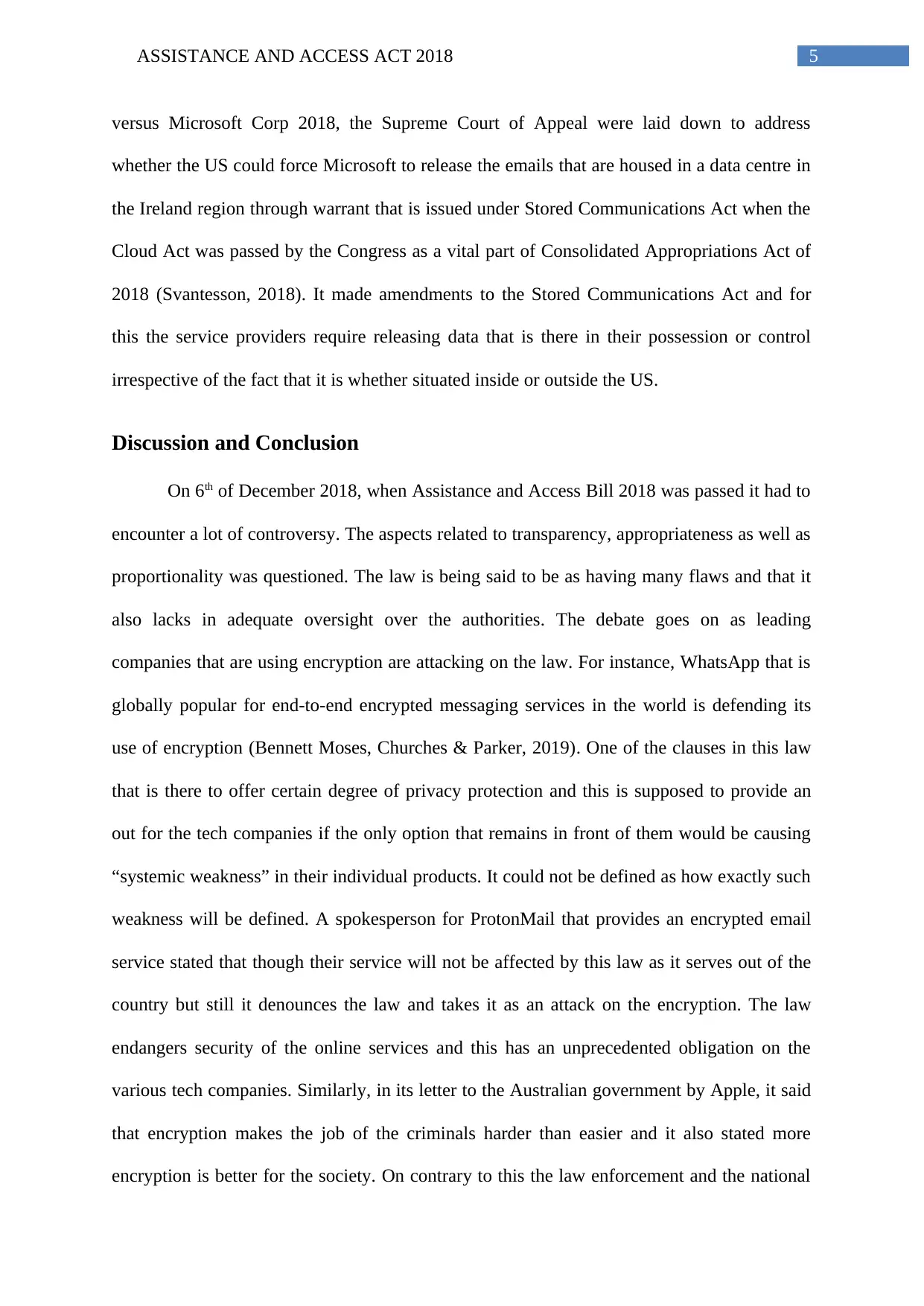
5ASSISTANCE AND ACCESS ACT 2018
versus Microsoft Corp 2018, the Supreme Court of Appeal were laid down to address
whether the US could force Microsoft to release the emails that are housed in a data centre in
the Ireland region through warrant that is issued under Stored Communications Act when the
Cloud Act was passed by the Congress as a vital part of Consolidated Appropriations Act of
2018 (Svantesson, 2018). It made amendments to the Stored Communications Act and for
this the service providers require releasing data that is there in their possession or control
irrespective of the fact that it is whether situated inside or outside the US.
Discussion and Conclusion
On 6th of December 2018, when Assistance and Access Bill 2018 was passed it had to
encounter a lot of controversy. The aspects related to transparency, appropriateness as well as
proportionality was questioned. The law is being said to be as having many flaws and that it
also lacks in adequate oversight over the authorities. The debate goes on as leading
companies that are using encryption are attacking on the law. For instance, WhatsApp that is
globally popular for end-to-end encrypted messaging services in the world is defending its
use of encryption (Bennett Moses, Churches & Parker, 2019). One of the clauses in this law
that is there to offer certain degree of privacy protection and this is supposed to provide an
out for the tech companies if the only option that remains in front of them would be causing
“systemic weakness” in their individual products. It could not be defined as how exactly such
weakness will be defined. A spokesperson for ProtonMail that provides an encrypted email
service stated that though their service will not be affected by this law as it serves out of the
country but still it denounces the law and takes it as an attack on the encryption. The law
endangers security of the online services and this has an unprecedented obligation on the
various tech companies. Similarly, in its letter to the Australian government by Apple, it said
that encryption makes the job of the criminals harder than easier and it also stated more
encryption is better for the society. On contrary to this the law enforcement and the national
versus Microsoft Corp 2018, the Supreme Court of Appeal were laid down to address
whether the US could force Microsoft to release the emails that are housed in a data centre in
the Ireland region through warrant that is issued under Stored Communications Act when the
Cloud Act was passed by the Congress as a vital part of Consolidated Appropriations Act of
2018 (Svantesson, 2018). It made amendments to the Stored Communications Act and for
this the service providers require releasing data that is there in their possession or control
irrespective of the fact that it is whether situated inside or outside the US.
Discussion and Conclusion
On 6th of December 2018, when Assistance and Access Bill 2018 was passed it had to
encounter a lot of controversy. The aspects related to transparency, appropriateness as well as
proportionality was questioned. The law is being said to be as having many flaws and that it
also lacks in adequate oversight over the authorities. The debate goes on as leading
companies that are using encryption are attacking on the law. For instance, WhatsApp that is
globally popular for end-to-end encrypted messaging services in the world is defending its
use of encryption (Bennett Moses, Churches & Parker, 2019). One of the clauses in this law
that is there to offer certain degree of privacy protection and this is supposed to provide an
out for the tech companies if the only option that remains in front of them would be causing
“systemic weakness” in their individual products. It could not be defined as how exactly such
weakness will be defined. A spokesperson for ProtonMail that provides an encrypted email
service stated that though their service will not be affected by this law as it serves out of the
country but still it denounces the law and takes it as an attack on the encryption. The law
endangers security of the online services and this has an unprecedented obligation on the
various tech companies. Similarly, in its letter to the Australian government by Apple, it said
that encryption makes the job of the criminals harder than easier and it also stated more
encryption is better for the society. On contrary to this the law enforcement and the national
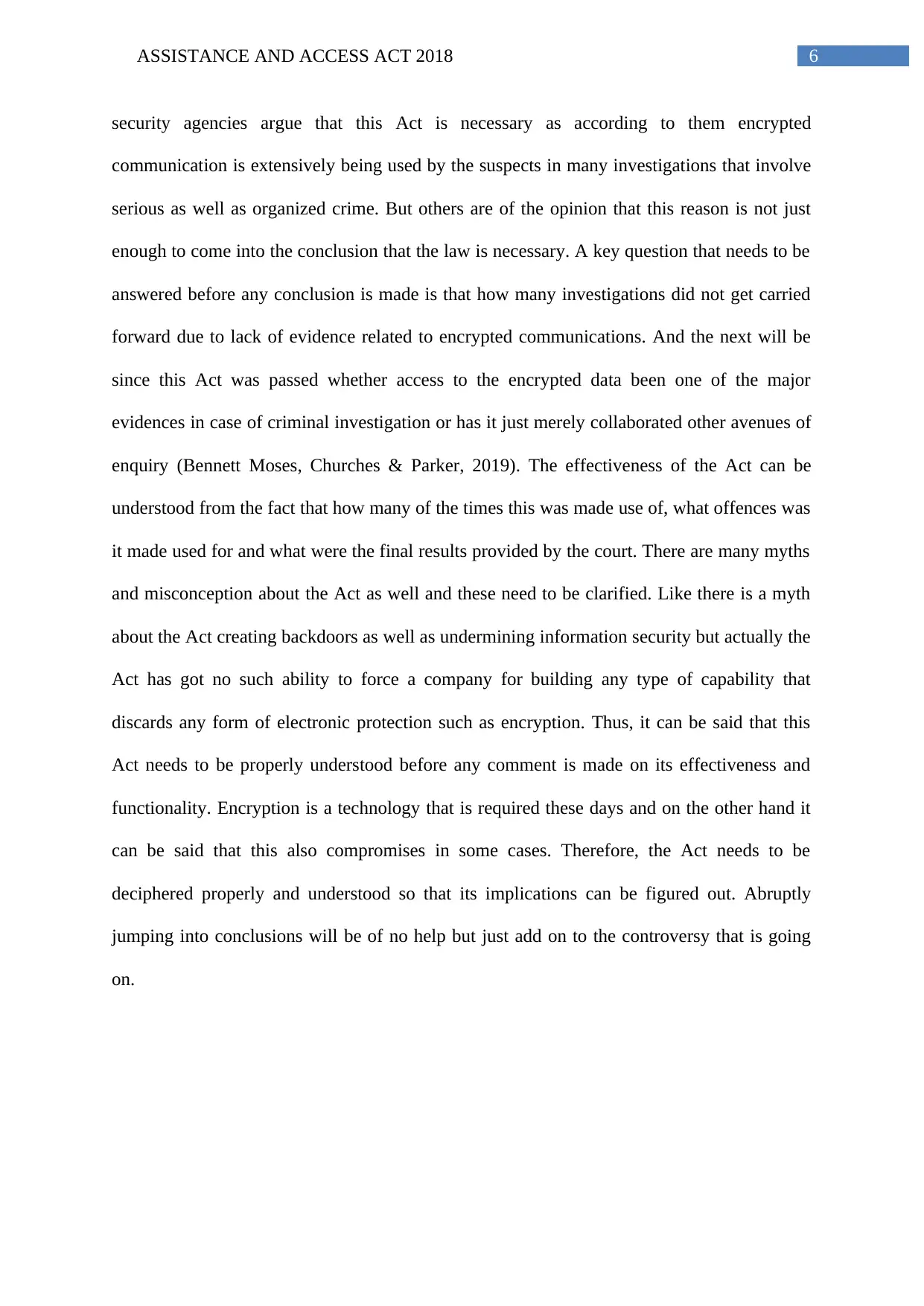
6ASSISTANCE AND ACCESS ACT 2018
security agencies argue that this Act is necessary as according to them encrypted
communication is extensively being used by the suspects in many investigations that involve
serious as well as organized crime. But others are of the opinion that this reason is not just
enough to come into the conclusion that the law is necessary. A key question that needs to be
answered before any conclusion is made is that how many investigations did not get carried
forward due to lack of evidence related to encrypted communications. And the next will be
since this Act was passed whether access to the encrypted data been one of the major
evidences in case of criminal investigation or has it just merely collaborated other avenues of
enquiry (Bennett Moses, Churches & Parker, 2019). The effectiveness of the Act can be
understood from the fact that how many of the times this was made use of, what offences was
it made used for and what were the final results provided by the court. There are many myths
and misconception about the Act as well and these need to be clarified. Like there is a myth
about the Act creating backdoors as well as undermining information security but actually the
Act has got no such ability to force a company for building any type of capability that
discards any form of electronic protection such as encryption. Thus, it can be said that this
Act needs to be properly understood before any comment is made on its effectiveness and
functionality. Encryption is a technology that is required these days and on the other hand it
can be said that this also compromises in some cases. Therefore, the Act needs to be
deciphered properly and understood so that its implications can be figured out. Abruptly
jumping into conclusions will be of no help but just add on to the controversy that is going
on.
security agencies argue that this Act is necessary as according to them encrypted
communication is extensively being used by the suspects in many investigations that involve
serious as well as organized crime. But others are of the opinion that this reason is not just
enough to come into the conclusion that the law is necessary. A key question that needs to be
answered before any conclusion is made is that how many investigations did not get carried
forward due to lack of evidence related to encrypted communications. And the next will be
since this Act was passed whether access to the encrypted data been one of the major
evidences in case of criminal investigation or has it just merely collaborated other avenues of
enquiry (Bennett Moses, Churches & Parker, 2019). The effectiveness of the Act can be
understood from the fact that how many of the times this was made use of, what offences was
it made used for and what were the final results provided by the court. There are many myths
and misconception about the Act as well and these need to be clarified. Like there is a myth
about the Act creating backdoors as well as undermining information security but actually the
Act has got no such ability to force a company for building any type of capability that
discards any form of electronic protection such as encryption. Thus, it can be said that this
Act needs to be properly understood before any comment is made on its effectiveness and
functionality. Encryption is a technology that is required these days and on the other hand it
can be said that this also compromises in some cases. Therefore, the Act needs to be
deciphered properly and understood so that its implications can be figured out. Abruptly
jumping into conclusions will be of no help but just add on to the controversy that is going
on.
Paraphrase This Document
Need a fresh take? Get an instant paraphrase of this document with our AI Paraphraser
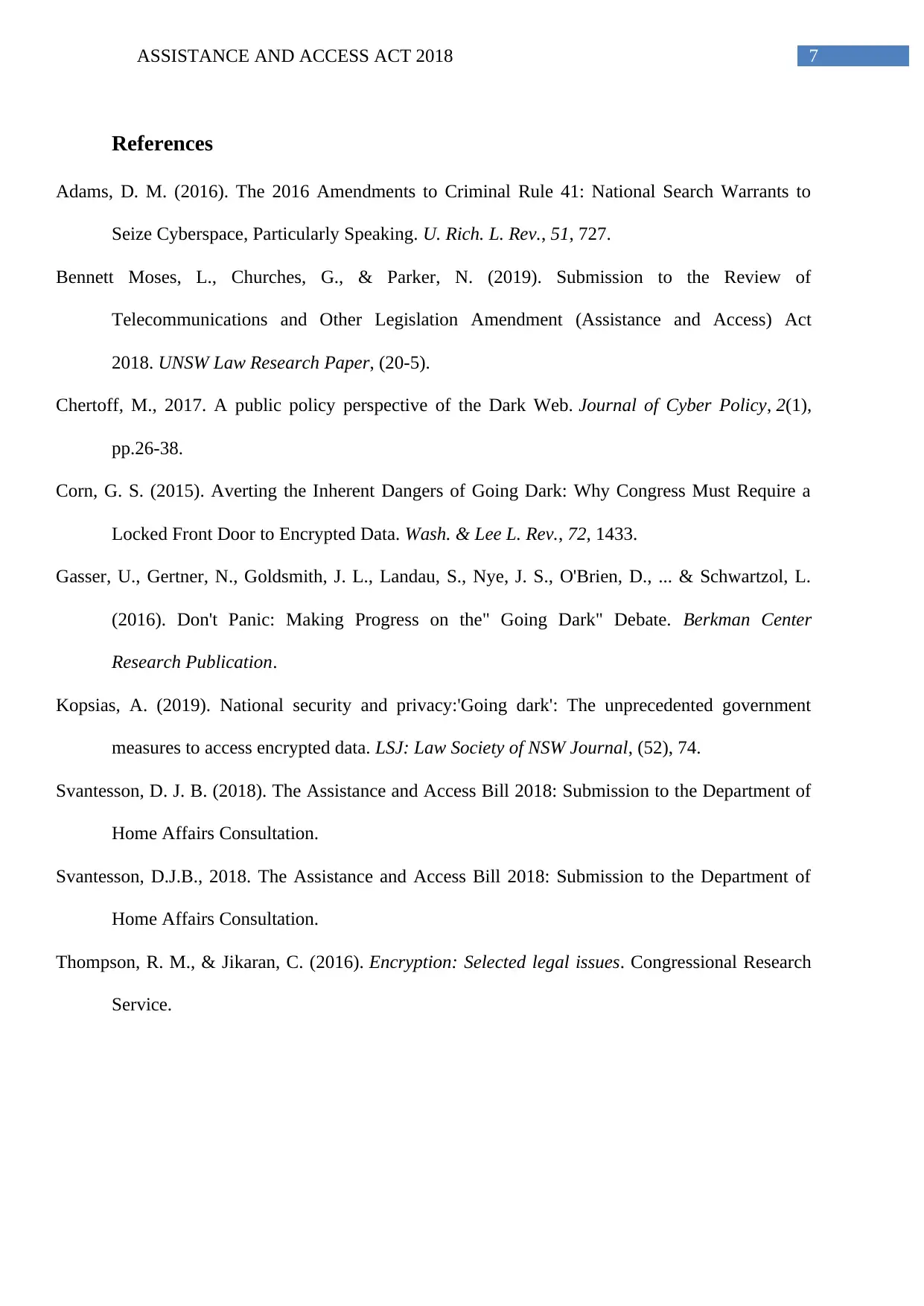
7ASSISTANCE AND ACCESS ACT 2018
References
Adams, D. M. (2016). The 2016 Amendments to Criminal Rule 41: National Search Warrants to
Seize Cyberspace, Particularly Speaking. U. Rich. L. Rev., 51, 727.
Bennett Moses, L., Churches, G., & Parker, N. (2019). Submission to the Review of
Telecommunications and Other Legislation Amendment (Assistance and Access) Act
2018. UNSW Law Research Paper, (20-5).
Chertoff, M., 2017. A public policy perspective of the Dark Web. Journal of Cyber Policy, 2(1),
pp.26-38.
Corn, G. S. (2015). Averting the Inherent Dangers of Going Dark: Why Congress Must Require a
Locked Front Door to Encrypted Data. Wash. & Lee L. Rev., 72, 1433.
Gasser, U., Gertner, N., Goldsmith, J. L., Landau, S., Nye, J. S., O'Brien, D., ... & Schwartzol, L.
(2016). Don't Panic: Making Progress on the" Going Dark" Debate. Berkman Center
Research Publication.
Kopsias, A. (2019). National security and privacy:'Going dark': The unprecedented government
measures to access encrypted data. LSJ: Law Society of NSW Journal, (52), 74.
Svantesson, D. J. B. (2018). The Assistance and Access Bill 2018: Submission to the Department of
Home Affairs Consultation.
Svantesson, D.J.B., 2018. The Assistance and Access Bill 2018: Submission to the Department of
Home Affairs Consultation.
Thompson, R. M., & Jikaran, C. (2016). Encryption: Selected legal issues. Congressional Research
Service.
References
Adams, D. M. (2016). The 2016 Amendments to Criminal Rule 41: National Search Warrants to
Seize Cyberspace, Particularly Speaking. U. Rich. L. Rev., 51, 727.
Bennett Moses, L., Churches, G., & Parker, N. (2019). Submission to the Review of
Telecommunications and Other Legislation Amendment (Assistance and Access) Act
2018. UNSW Law Research Paper, (20-5).
Chertoff, M., 2017. A public policy perspective of the Dark Web. Journal of Cyber Policy, 2(1),
pp.26-38.
Corn, G. S. (2015). Averting the Inherent Dangers of Going Dark: Why Congress Must Require a
Locked Front Door to Encrypted Data. Wash. & Lee L. Rev., 72, 1433.
Gasser, U., Gertner, N., Goldsmith, J. L., Landau, S., Nye, J. S., O'Brien, D., ... & Schwartzol, L.
(2016). Don't Panic: Making Progress on the" Going Dark" Debate. Berkman Center
Research Publication.
Kopsias, A. (2019). National security and privacy:'Going dark': The unprecedented government
measures to access encrypted data. LSJ: Law Society of NSW Journal, (52), 74.
Svantesson, D. J. B. (2018). The Assistance and Access Bill 2018: Submission to the Department of
Home Affairs Consultation.
Svantesson, D.J.B., 2018. The Assistance and Access Bill 2018: Submission to the Department of
Home Affairs Consultation.
Thompson, R. M., & Jikaran, C. (2016). Encryption: Selected legal issues. Congressional Research
Service.
1 out of 8
Your All-in-One AI-Powered Toolkit for Academic Success.
+13062052269
info@desklib.com
Available 24*7 on WhatsApp / Email
![[object Object]](/_next/static/media/star-bottom.7253800d.svg)
Unlock your academic potential
© 2024 | Zucol Services PVT LTD | All rights reserved.


